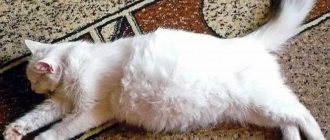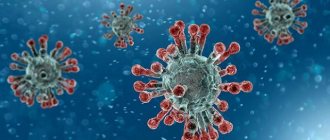Definition of disease
Feline viral peritonitis is a highly contagious disease characterized by damage to the immune system. The peculiarity of FIP is a very long incubation period and the absence of specific symptom complexes that complicate early diagnosis.
Pathogen
FIP is caused by RNA viruses, which are classified as coronaviruses. This family is large, but only two strains affect cats:
- Feline enteric coronavirus (FECV, feline viral enteritis). Manifests itself as symptoms of gastrointestinal disorders (diarrhea, vomiting). After about 3-5 days, the symptoms subside, and it seems that there is no longer an infection in the animal’s body. In fact, the cat remains a carrier of the virus for a long time and releases it into the external environment.
- Feline infectious peritonitis virus (FIPV, feline viral peritonitis). In the early stages it has no specific symptoms and begins spontaneously and suddenly. It is characterized by damage to the immune system (T-lymphocytes - macrophage cells), depriving the body of its main defense against external pathogens.
There is an opinion that the causative agent of viral enteritis (FICV) causes dry peritonitis in cats, and the causative agent FIPV causes its wet form.
Mechanism of disease development
The coronavirus penetrates through the villi of epithelial cells lining the oral or nasal cavity and nasopharynx. Further, pathogenesis can develop in two ways: either a dry form with initial symptoms of digestive disorders, or a wet form, which has no specific symptoms at the first stage.
In the dry form of feline infectious peritonitis, the virus can remain in the body for a very long time and not manifest itself in any way. But under certain circumstances, its virulence increases (a kind of natural passage of the strain) and its pathogenicity increases sharply.
Important! The virus can “sleep” in a cat’s body for a very long time. Perhaps this is influenced by the general condition of the body, its ability to resist pathogenic agents.
With the wet form of feline infectious peritonitis, the process develops much more dynamically, but specific visual signs appear only in the last stages.
After the virus becomes as pathogenic as possible, the immune system responds by releasing macrophages into the blood - T lymphocytes, and then B lymphocytes. These are tools of humoral immunity that are responsible for the formation of a specific immune response and nonspecific protection.
Most often, these measures are enough to overcome the disease, but there are a number of pathologies in which viral particles infect cells of the immune system. These are immunodeficiency diseases, which also include peritonitis.
In this case, the main target of the virus will always be the immune system and its “tools”. This is the only protector of a living organism that nature has endowed it with.
During a viral attack, the released macrophages do not fully perform their function - they absorb aggressive particles, but cannot kill them. As a result, the virus feeds on the reserves of the affected macrophage, destroys it and comes out unharmed.
But the pathogenic effect of the virus does not end there; it penetrates all organs and tissues. A large number of aggressive particles accumulate in places where there are many small capillaries - in the liver, spleen and other organs.
When the immune system is weakened, under the influence of the virus, the porosity of the capillaries (the permeability of the vascular walls) increases and part of the liquid fraction of the blood goes beyond their limits. Fluid accumulates in the abdominal cavity, causing ascites (dropsy) and inflammation of the peritoneum. This is how a transient wet form of peritonitis develops.
If the immune system is strong enough, it actively resists and manages to produce antibodies to the virus. Then the process of struggle is delayed, but all internal organs are also involved in it. This is the dry form of FIP.
Routes of infection and spread of peritonitis
A cat becomes infected through contact with a source of infection. Coronaviruses do not have significant resistance to environmental factors. After identifying an infection, it is recommended to wait 2-4 months (depending on the disinfection treatments carried out in places of detention) before getting a new animal.
The virus can be transmitted through contact and nutrition. In addition to sick animals, household items can serve as a source of infection - feeding dishes, tray, bed, and so on. Also, a sick cat can transmit the infection to kittens during birth or feeding.
FIP is a common disease, more often found in places with large concentrations of animals (in shelters, nurseries, at exhibitions).
Attention! Cats under 2 and over 10 years of age are most susceptible to FIP. British cats have a predisposition to viral peritonitis.
How can a cat become infected?
Most often, a cat receives the pathogen through infected feces from an already sick animal. The FCoV virus can enter the body through mucous membranes by coming into contact with sick cats or by visiting a place where there is their feces.
Sometimes cats re-infect themselves by licking themselves. According to statistics, up to 40% of cats are infected with the peritonitis virus during their lives, which, however, in most cases goes unnoticed by their owners.
Failure and green light for the virus to mutate into a dangerous type can be given by other infections that weaken the immune system, surgery, pregnancy, change of place of residence, change of diet. Genetics also plays a role in triggering the development of the disease. In general, this issue is still open to discussion in scientific communities.
Can a person become infected with peritonitis?
There is no reason for owners of infected cats to worry about themselves and their loved ones: people are not infected with feline coronavirus.
Clinical symptoms of peritonitis
Clinical symptoms of peritonitis in cats can be varied, but this disease does not have specific symptom complexes.
Wet form (exudative)
If this is a strain that immediately causes the wet form of FIP, then there are no specific symptoms, but general signs of illness are present:
- temperature increase;
- oppression;
- refusal to eat or noticeable loss of appetite;
- anemic.
After the first nonspecific symptoms, signs of dropsy and peritonitis in the cat rapidly develop:
- Ascites and/or pleural/abdominal effusions.
- Low-grade or intermittent fever.
- With effusion into the pleural cavity, breathing problems occur.
- Weight loss.
- On palpation there is an enlargement of the liver and mesenteric lymph nodes.
- When the disease spreads to other organs, symptoms characteristic of their dysfunction.
- Sometimes (usually in the dry form) damage to the nervous system and eyes.
Dry form (non-exudative)
If this is a strain that initially causes viral enteritis, then a picture of gastrointestinal distress begins to develop:
- Appetite decreases or is absent altogether, weight decreases.
- Activity is reduced.
- Vomiting and diarrhea appear.
- Pallor of visible mucous membranes.
- Damage to the nervous system and eyes appears.
- Body temperature rises.
Further, the clinical picture of peritonitis develops depending on which organs are involved in the process. These may be signs of diseases of the respiratory system, digestion, liver, and circulatory system.
Flow
- In the first stages, the causative agent of viral peritonitis enters the body through the organs of the digestive tract and respiratory system, where it settles in the tonsils, then proceeds to develop in the intestinal cells.
- In the animal’s body, the virus begins to actively multiply in macrophage cells, which becomes the cause of a generalized course of the disease. Macrophages become a kind of carrier of the pathogen throughout the body.
- The virus enters the blood through macrophages, resulting in viremia.
- In the case of strong immunity, the body suppresses the development of the pathogen in macrophages and infectious peritonitis does not develop in the kitten.
- In the absence of an immune response, feline coronavirus will actively multiply in macrophages, which spread throughout the body. Their greatest concentration occurs in places of high concentration of blood vessels, which determines their location under the serous membranes. In this case, wet or exudative peritonitis develops.
- In the case where an immune response to the penetration of the virus into the body occurred, but it was not enough to prevent the disease, the level of affected macrophages spreading throughout the body is significantly lower. In this case, the cat develops proliferative or dry peritonitis.
- In some cases, the development of viral peritonitis is suppressed by the immune system, but after some time the disease still spreads.
- Previous infection leads to the formation of antibodies to other strains of the virus, which contributes to the formation of an antibody-antigen complex, which is carried by macrophages throughout the body; in places where blood vessels accumulate, such complexes cause damage to the vascular wall. This process is typical for exudative peritonitis, in which liquid containing a large amount of proteins leaks through the damaged vascular wall.
How long do cats with peritonitis live?
According to statistics, the mortality rate with infectious peritonitis is about 90%. If the type of peritonitis is bacterial, then the chances of survival increase to 50%.
Symptoms
Viral peritonitis in a kitten can manifest itself in different ways, the intensity of the disease depends on the virulence of the strain, the condition of the cat’s body and its age.
The incubation period in cats can last from several weeks to several months, depending on the amount of pathogen and the state of the cat's immunity.
Depending on the course of the disease, various symptoms may appear:
- In kittens . Lethargy develops, the temperature can rise to 40 degrees, signs of peritonitis are observed, and there is a possibility of developing pleurisy.
- In adults . There are two forms of the disease with different symptoms: Wet peritonitis. Fluid accumulates in the abdominal and chest cavity. This leads to the animal having difficulty breathing, shortness of breath, and murmurs in the heart area upon auscultation.
- Disease without accumulation of exudate. In this case, the symptoms will depend on which organs are affected: Eyes. The first manifestation of FIP in cats is the development of conjunctivitis, followed by lesions of the retina and iris.
- Kidneys. Development of glomerulonephritis.
- Liver. With liver damage, yellowness of the skin and mucous membranes and pain in the liver area are observed.
- Lungs. Bronchopneumonia develops.
- Nervous system. Extreme skin sensitivity, paresis or paralysis may occur.
Lifelong diagnosis
Peritonitis in a cat has similar clinical signs to other infectious diseases; for different forms, symptoms and treatment differ, so the diagnosis should only be made by a specialist.
The final analysis is based on serological blood tests confirming the presence of antibodies to coronaviruses and PCR. Detection of a virus in the body is a weak argument for making a final diagnosis, because It is impossible to determine the strain of the virus during research.
Differentiation of the feline peritonitis virus can be reliably established through post-mortem diagnosis of dead animals.
Post-mortem diagnosis
Diagnosed based on the results of the autopsy and histological studies of the affected organs.
Autopsy results
Necrotic plaques in viral peritonitis
- The animal is severely emaciated.
- Detection of a large amount of fluid in the abdominal and chest cavity. The nature of the exudate is transparent, straw-colored; minor impurities of fibrin threads may be observed.
- Serous membranes have a dull color due to the accumulation of fibrin protein on their surface, which also causes dense adhesions on the surface of the membranes.
- White necrotic plaques can be seen on the surface of the internal organs.
- Enlarged lymph nodes; when cut, a characteristic pattern is clearly visible.
- In the proliferative form, there may be inflamed foci in the organs.
Danger to humans
Although peritonitis is practically incurable, it is not transmitted in any way from a cat and is absolutely safe for humans.
Differential diagnoses
The dry form of FIP is differentiated from the following diseases:
- cardiomyopathy;
- liver diseases (including tumors);
- purulent serositis;
- lymphosarcoma;
- obesity.
The wet (exudative, exudative) form of FIP is differentiated from the following pathologies:
- feline leukemia virus;
- feline immunodeficiency virus;
- oncological diseases;
- hyperthyroidism (in older cats);
- toxoplasmosis;
- fungal infections;
- idiopathic diseases;
- urinary tract obstruction;
- autoimmune anemia;
- Feline spongiform encephalopathy.
Predictions for the animal
The wet form of VIP is more severe: the prognosis for life is always unfavorable: only 6-7 months. The dry variety, with proper care, allows cats to live a couple of years longer, but such data is also not entirely indicative: in cats with this form of infection, repeated tests showed a negative antibody test result - the cat was probably already at the “healing” stage at the time the first ones were taken analyses.
global $ads_google; //data-ad-slot=”2475549904″ $ads_google = empty($ads_google) ? false : true; ?> if ($ads_google == false) {?>
$ads_google = true; ?> } ?>
If you quickly remove the effusion fluid, the disease can turn into a dry form.
Diagnostics
Peritonitis is very difficult to diagnose. Lifetime diagnosis cannot be based solely on history taking and visual examination. Even a very experienced specialist is not able to determine FIP with 100% accuracy without additional laboratory tests. But even among them there is not a single one who would immediately confirm the presence of a virulent strain of coronavirus.
History taking
Collecting information about the animal is necessary for the veterinarian to quickly understand what diseases to focus on when making a diagnosis. This includes the owner’s “complaints” and his interview with a specialist.
The anamnesis includes the following information:
- view;
- floor;
- age;
- live weight;
- breed;
- availability of preventive vaccinations and treatments against ecto- and endoparasites;
- type, conditions of keeping and feeding;
- information about appetite, urination and defecation;
- Body temperature;
- frequency and purity of breathing, heart contractions;
- assessment of animal behavior (active/inactive, odd behavior);
- information about past illnesses;
- information about the presence of stressful situations and contacts of the sick person with other animals in the recent past.
Important! The more accurately the anamnesis is collected, the faster the diagnosis will be made. Typically, owners do not attach importance to many aspects of their pets' lives and do not talk about them. In such cases, the veterinarian himself asks the necessary questions.
Laboratory methods for diagnosing peritonitis
To confirm the diagnosis of “feline infectious viral peritonitis” in any of its forms, it is necessary to conduct research using several methods and obtain a confirmatory result for each of them.
To diagnose peritonitis, the following methods are used:
- Cytological and biochemical examination of effusion from the abdominal and/or thoracic cavity.
- Biochemical and hematological blood tests.
- Serological tests for the presence of antibodies (ELISA, RTGA, RN).
- To indicate the virus - reverse CPR, RIF, ELISA (analysis of circulating immune complexes).
- Histopathological examination of affected tissues.
Materials for laboratory research can be:
- whole blood;
- blood serum;
- effusion;
- saliva;
- feces;
- rectal swabs;
- particles of organs and tissues.
Important! In the wet form of peritonitis, the clinical signs are obvious, while in the dry form they may be subtle.
Instrumental methods
Instrumental examination involves the use of special veterinary (medical) equipment. If FIP is suspected, the following is performed:
- Ultrasound of the abdominal cavity (to identify granulomas on internal organs, accumulation of exudate, intestinal inflammation).
- Abdominal puncture (to collect a sample of exudate).
- X-ray (to determine the presence of abdominal ascites).
- Biopsy (for histological examination).
Important! X-rays are only ordered if the cat is experiencing shortness of breath or difficulty breathing.
How to prevent infectious peritonitis
Today there is no effective vaccine against coronavirus. In the USA, it is under development, but has not yet passed all the required stages of research. In this regard, the vaccine is prohibited in Europe and Russia.
Many experts in the field of veterinary medicine believe that good living conditions and a favorable psychological climate will allow cats or cats to avoid the development of such a terrible disease as peritonitis. Among the measures to prevent animal infection are:
- prevent eating the excrement of other cats;
- in case of a large concentration of animals in a relatively small area, for example, in an apartment, keep pregnant cats separately from other animals; the same rule applies to kittens and older pets;
- ensure a favorable psychological climate, absence of stress;
- strengthen immunity;
- give multivitamin complexes recommended by a veterinarian;
- periodically process or change the animal’s things: tray, bowls, toys;
- See a veterinarian regularly;
- avoid contact with other cats, especially street cats;
- Follow the veterinarian’s recommendations after surgery or sterilization of the animal.
1111
Treatment and prognosis for peritonitis
The prognosis for FIP is extremely poor. With the wet form of the flow, the life expectancy of a pet usually does not exceed 6 months. There is no effective treatment for feline viral peritonitis.
Any of its forms ends in death. If the animal is not in satisfactory physical condition, with a confirmed diagnosis, veterinarians recommend euthanasia, since attempts to treat this disease cause a lot of physical suffering to the cat, and the animal itself is a source of infection.
Meanwhile, with the dry form of peritonitis, an animal can live up to 5 years with appropriate maintenance therapy. Only a veterinarian can prescribe it.
Expert opinion
Chepa Natalya Semenovna
Veterinarian
Ask an expert
Recently, a terrible diagnosis has ceased to sound like a death sentence. Protease inhibitors of the GS group are used to treat the disease. The effectiveness and safety of GS-441524 was proven in a study by a group of American scientists led by Professor Pedersen. GS medications are very expensive and can only be purchased abroad, but this is the only chance today to help your pet overcome a fatal disease.
Neonatal peritonitis of kittens
The virus can cause fading of newborn kittens and their sudden death.
The baby is observed:
- weight loss
- weakness
- exhaustion
- general deterioration of condition
- labored breathing
- cyanosis of the skin and mucous membranes
- death within a few hours from circulatory collapse
The infection is especially dangerous for nurseries, where entire litters of kittens die from viral peritonitis. When the first clinical signs appear, you should seek help from a veterinarian as soon as possible.
Control and prevention of peritonitis
There is no specific prevention of FIP with proven effectiveness yet. Therefore, the main preventive measures are considered to be:
- Strengthening immunity and nonspecific resistance.
- Preventing stressful situations.
- Limit contact with unfamiliar and suspicious (for diseases) animals.
- Control of animal cleanliness.
- Compliance with hygiene standards.
- Proper nutrition.
- Visit the veterinarian once every 6 months for a preventive examination.
In kittens
There are no special rules for preventing FIP for older kittens, so the same techniques apply to them as for adult animals. But if kittens are born to a sick cat, then they are taken from their mother as early as possible - at the age of 4-6 weeks, until they stop receiving her ready-made antibodies to FIP through breast milk.
This is due to the short period of decay of maternal antibodies. A kitten that is removed from an infected mother later in life can also become infected with the coronavirus.
Important! At 10 weeks of age, it is recommended that kittens be tested for antibodies to FIP.
Prevention in places of detention
Where there are large numbers of cats, prevention and control are limited to the following measures:
- Disinfection of places of detention and care items.
- Maintaining quarantine when new animals appear.
- Compliance with general preventive measures for FIP.
In clinically healthy cats infected with coronavirus
The presence of antibodies to coronavirus does not at all prove that the cat has FIP. For cats without clinical signs of FIP, but with a low titer of antibodies to coronavirus, it is recommended:
- Avoid stress.
- Provide balanced nutrition and rest.
- Postpone previously planned surgical interventions, preventive vaccinations and treatments, matings.
- Later, recheck the blood for the presence of antibodies to coronavirus. If they disappear, then you can return to the normal rhythm of life. If the number of antibodies has increased, then you should undergo a detailed examination and, if necessary, treatment.
Is it possible to cure a sick cat?
Let's start with the fact that there is simply no classical treatment regimen. In addition, extensive internal damage may turn out to be “outdated,” which threatens to reduce the likelihood of healing to a minimum.
Important! If there is an exacerbation, you can apply ice to the abdomen (if, of course, the pet allows it). Due to the rapid development of viral type peritonitis, it is treated comprehensively:
Due to the rapid development of viral type peritonitis, it is treated comprehensively:
- It all starts with removing exudate using a puncture. In some cases, a blood transfusion is also performed at the same time.
- If the pet’s condition allows you to do without them, a course of therapy is prescribed. Typically, injections of Penicillin, Cephalosporin or sulfonamide compounds are used. Enterostat, used by many doctors, along with its analogue Fosprenil, do not give much effect.
- To eliminate symptoms, vitamin complexes with the obligatory presence of compounds of groups B and C are prescribed.
- Neutralization of a pathogenic virus is a task for Cyclophosphamide, Prednisolone or similar drugs.
- The result is secured with immunostimulants like Interferon or Immunoglobulin.
Did you know? All cats are naturally predisposed to farsightedness - they are able to see an object from a distance of 60 m! But striped animals most clearly perceive objects located at a distance of 0.75-6 m.
Doses, rates and frequency of administration are determined only by a veterinarian. The owner is required to take extra care of the animal. It comes down to using feed that is rich in vitamins (but at the same time “light” on the stomach).
Many people are interested in how viral peritonitis found in cats affects how long they live after it is detected.
Unfortunately, the prognosis is consistently (90%) unfavorable - with the exudative version, experts give the cat a few days to a month. With the proliferative form the situation is slightly different: here the count starts from 3 weeks to six months (and this is the maximum).
The time frame may be even shorter if there is a history of leukemia (at least 20% of cases of infection occur in such animals).
It is not surprising that in this situation, prevention plays a huge role.











